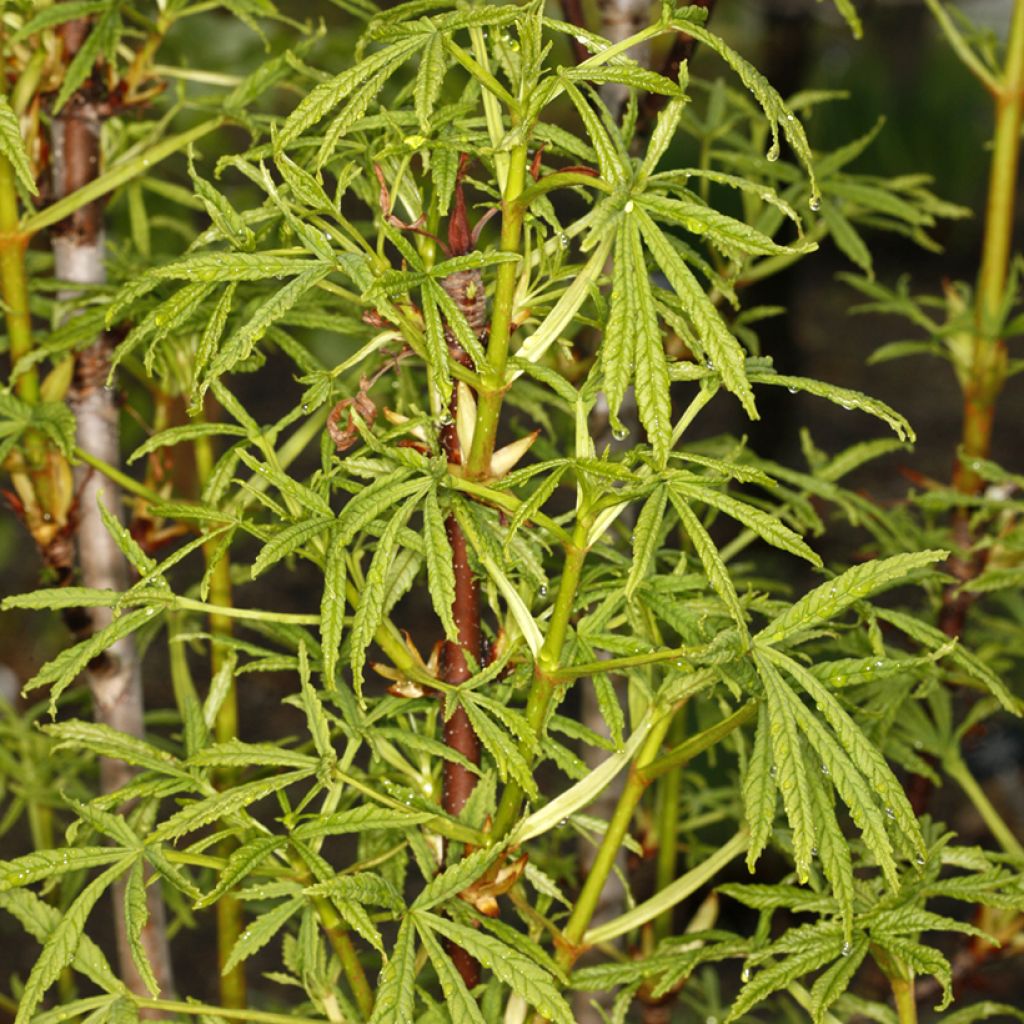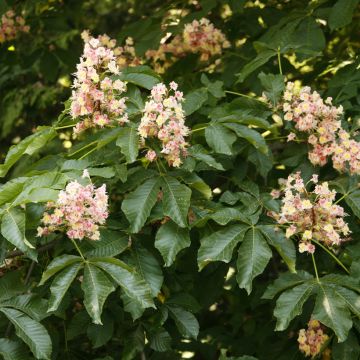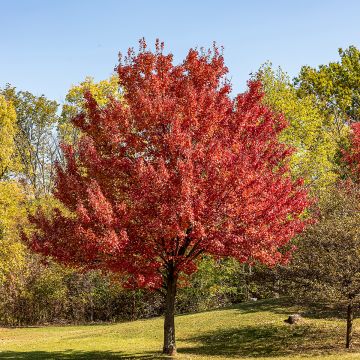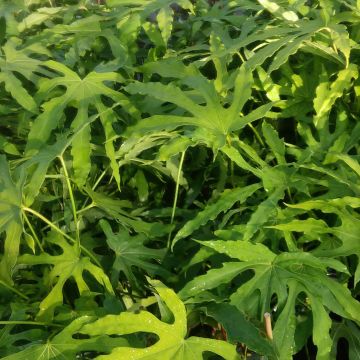

Aesculus hippocastanum Digitata - European horse Chestnut
Aesculus hippocastanum Digitata - European horse Chestnut
Aesculus hippocastanum Digitata
European horse Chestnut, Horse Chestnut, Conker Tree
This item cannot be shipped to the selected country
Oversize package delivery charge from €6.90
More information
Schedule delivery date,
and select date in basket
This plant carries a 24 months recovery warranty
More information
We guarantee the quality of our plants for a full growing cycle, and will replace at our expense any plant that fails to recover under normal climatic and planting conditions.
Oversize package: home delivery by special carrier from €6.90 per order..
Express home delivery from €8.90.
Does this plant fit my garden?
Set up your Plantfit profile →
Description
Aesculus 'Digitata' is a hybrid between Aesculus hippocastanum, the horse chestnut tree, and an unidentified American species of Pavier. It is a deciduous tree with moderate development and slow growth, more suitable for smaller gardens. The leaves of this variety are smaller and more finely cut than those of the common horse chestnut, giving the vegetation a finer texture. Its spring flowering is pale pink and less spectacular, and fruiting is rare.
Aesculus 'Digitata' is sometimes marketed under the name Aesculus 'Pumila'. This hybrid variety was created in France before 1864. This small horse chestnut tree belongs to the Sapindaceae or Hippocastanaceae family, depending on the classification. It grows slowly to very slowly and can reach a height of 6 to 8 m with a spread of 5 to 8 m after many years. It develops a straight trunk covered with brown bark, initially smooth, becoming grey and fissured with age. The crown is fairly wide, with a pyramid shape and dense foliage. The deciduous foliage appears in spring and falls in autumn. In winter, small reddish buds covered with shiny resin can be seen on the branches. The leaves have 3 to 5 small, short and narrow leaflets. They are attached to the branches by a petiole with 2 narrow wings. Flowering occurs in May-June, on the already leafy branches. It takes the form of upright pyramid-shaped clusters called thyrses, measuring about 15 cm long and composed of numerous small flowers about 1 cm wide. These flowers are white with a delicate pink hue inside. They are nectar-rich. The 'Digitata' horse chestnut tree produces very few fruits. When they form, they measure 3 to 4 cm in diameter, they are smooth, adorned with a few delicate thorns, and are green-brown. The root system of this horse chestnut tree is deep and taproot, it does not like to be disturbed.
The 'Digitata' Horse Chestnut tree can tolerate any deep soil that remains slightly moist in summer, even limestone. It can be planted as a specimen tree in a clear location, on a large lawn, or as a shade tree near a terrace. Consider its future growth before planting it in the garden. You can plant it in all regions, but it will become taller and more beautiful if it benefits from a slightly humid climate and fairly rich soil. Mop-head hydrangeas, very flowey in summer, can provide a pleasant contrast with the dark green foliage of the horse chestnut tree. Capable of tolerating partial shade, they can thrive near this tree. At its base, you can plant hostas, ferns, or Japanese grasses (Hakonechloa) if the soil does not dry out too much in summer. Otherwise, opt for periwinkles or violets.
Report an error about the product description
Aesculus hippocastanum Digitata - European horse Chestnut in pictures


Plant habit
Flowering
Foliage
Botanical data
Aesculus
hippocastanum
Digitata
Sapindaceae
European horse Chestnut, Horse Chestnut, Conker Tree
Aesculus 'Pumila', Aesculus hippocastanum 'Digitata'
Cultivar or hybrid
Other Aesculus - Horse Chestnut
Planting and care
The 'Digitata' Chestnut Tree is best planted in spring or autumn in ordinary, but deep soil, preferably quite rich and slightly moist, slightly acidic, neutral or slightly alkaline. Place it in a sunny or semi-shaded location, in a well-cleared area. Give it some space, as it can reach a width of 4-5m for the crown. Water and mulch to maintain soil moisture for young plants. Once well-rooted, it will generally rely on rainwater, in not too dry climates. Pruning may be necessary for larger specimens to limit the size of the crown or remove lower branches in winter. To limit attacks from pests (rarely fatal), collect the leaves in autumn and dispose of them. Trapping male butterflies using a sexual pheromone (funnel traps) helps to reduce attacks.
Planting period
Intended location
Care
This item has not been reviewed yet - be the first to leave a review about it.
Striking foliage shrubs
Haven't found what you were looking for?
Hardiness is the lowest winter temperature a plant can endure without suffering serious damage or even dying. However, hardiness is affected by location (a sheltered area, such as a patio), protection (winter cover) and soil type (hardiness is improved by well-drained soil).

Photo Sharing Terms & Conditions
In order to encourage gardeners to interact and share their experiences, Promesse de fleurs offers various media enabling content to be uploaded onto its Site - in particular via the ‘Photo sharing’ module.
The User agrees to refrain from:
- Posting any content that is illegal, prejudicial, insulting, racist, inciteful to hatred, revisionist, contrary to public decency, that infringes on privacy or on the privacy rights of third parties, in particular the publicity rights of persons and goods, intellectual property rights, or the right to privacy.
- Submitting content on behalf of a third party;
- Impersonate the identity of a third party and/or publish any personal information about a third party;
In general, the User undertakes to refrain from any unethical behaviour.
All Content (in particular text, comments, files, images, photos, videos, creative works, etc.), which may be subject to property or intellectual property rights, image or other private rights, shall remain the property of the User, subject to the limited rights granted by the terms of the licence granted by Promesse de fleurs as stated below. Users are at liberty to publish or not to publish such Content on the Site, notably via the ‘Photo Sharing’ facility, and accept that this Content shall be made public and freely accessible, notably on the Internet.
Users further acknowledge, undertake to have ,and guarantee that they hold all necessary rights and permissions to publish such material on the Site, in particular with regard to the legislation in force pertaining to any privacy, property, intellectual property, image, or contractual rights, or rights of any other nature. By publishing such Content on the Site, Users acknowledge accepting full liability as publishers of the Content within the meaning of the law, and grant Promesse de fleurs, free of charge, an inclusive, worldwide licence for the said Content for the entire duration of its publication, including all reproduction, representation, up/downloading, displaying, performing, transmission, and storage rights.
Users also grant permission for their name to be linked to the Content and accept that this link may not always be made available.
By engaging in posting material, Users consent to their Content becoming automatically accessible on the Internet, in particular on other sites and/or blogs and/or web pages of the Promesse de fleurs site, including in particular social pages and the Promesse de fleurs catalogue.
Users may secure the removal of entrusted content free of charge by issuing a simple request via our contact form.
The flowering period indicated on our website applies to countries and regions located in USDA zone 8 (France, the United Kingdom, Ireland, the Netherlands, etc.)
It will vary according to where you live:
- In zones 9 to 10 (Italy, Spain, Greece, etc.), flowering will occur about 2 to 4 weeks earlier.
- In zones 6 to 7 (Germany, Poland, Slovenia, and lower mountainous regions), flowering will be delayed by 2 to 3 weeks.
- In zone 5 (Central Europe, Scandinavia), blooming will be delayed by 3 to 5 weeks.
In temperate climates, pruning of spring-flowering shrubs (forsythia, spireas, etc.) should be done just after flowering.
Pruning of summer-flowering shrubs (Indian Lilac, Perovskia, etc.) can be done in winter or spring.
In cold regions as well as with frost-sensitive plants, avoid pruning too early when severe frosts may still occur.
The planting period indicated on our website applies to countries and regions located in USDA zone 8 (France, United Kingdom, Ireland, Netherlands).
It will vary according to where you live:
- In Mediterranean zones (Marseille, Madrid, Milan, etc.), autumn and winter are the best planting periods.
- In continental zones (Strasbourg, Munich, Vienna, etc.), delay planting by 2 to 3 weeks in spring and bring it forward by 2 to 4 weeks in autumn.
- In mountainous regions (the Alps, Pyrenees, Carpathians, etc.), it is best to plant in late spring (May-June) or late summer (August-September).
The harvesting period indicated on our website applies to countries and regions in USDA zone 8 (France, England, Ireland, the Netherlands).
In colder areas (Scandinavia, Poland, Austria...) fruit and vegetable harvests are likely to be delayed by 3-4 weeks.
In warmer areas (Italy, Spain, Greece, etc.), harvesting will probably take place earlier, depending on weather conditions.
The sowing periods indicated on our website apply to countries and regions within USDA Zone 8 (France, UK, Ireland, Netherlands).
In colder areas (Scandinavia, Poland, Austria...), delay any outdoor sowing by 3-4 weeks, or sow under glass.
In warmer climes (Italy, Spain, Greece, etc.), bring outdoor sowing forward by a few weeks.























































